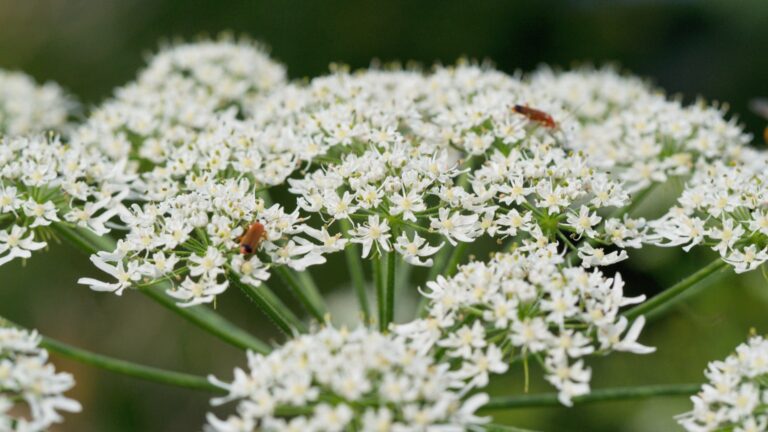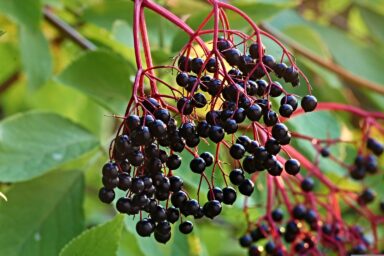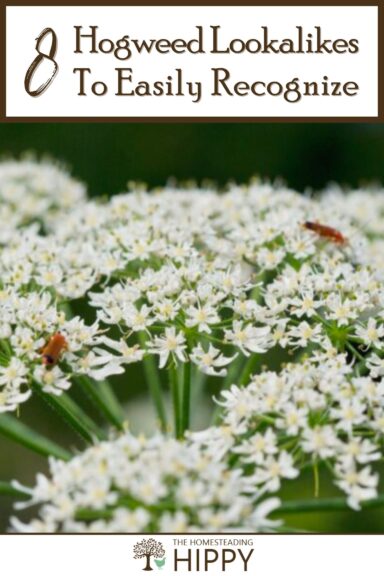If you’ve ever come across a truly towering plant crowned by multiple umbrella-like tops of delicate white flowers, you might have had an encounter with hogweed.

Also known as giant hogweed, this obnoxious and invasive plant has quickly become infamous because of its sheer toxicity.
Hogweed is truly awful, releasing a phototoxic sap that will react with sunlight to cause severe skin irritation and blistering. It can even cause blindness!
Trust me, it’s as bad as it sounds but it also has several look-alikes that are just as dangerous – or even more so! A few imposters are innocent, but not many.
Keep reading, and I’ll tell you how to identify each of these plants…
Table of Contents
1. Poison Hemlock (Conium maculatum)
You might stumble upon Poison Hemlock, Conium maculatum, while exploring any sunny areas, wide open fields, or even vacant lots if the underlying soil is favorable.
This dreadfully deadly plant is a highly toxic biennial is often mistaken for wild carrot (Queen Anne’s Lace) due to its similar appearance.
It is also, of course, mistaken for Hogweed but I’m not sure which one I would rather take my chances with.
Luckily, I suppose, there are key differences that can help you distinguish between the two. Poison Hemlock can grow up to a towering 12 feet in height and usually develops into a rosette in its first year.
In its second year, it matures by developing a tall flowering stalk. The stems of this plant are hollow, hairless, and ridged, displaying reddish or purple mottling on the lower limbs.
The leaves are finely divided and have a lacy appearance, quite similar to those of a carrot plant and of Hogweed.
Like Hogweed, despite its alluring look, remember that Poison Hemlock is terribly toxic, and even small amounts can harm or kill animals and people.
Every part of the plant, from the roots to the sap and even the blooms and seeds are poisonous, and toxins can be absorbed through the skin or inhaled! Keep your distance!
2. Water Hemlock (Cicuta maculata)
The hits keep on coming with the Hogweed lookalikes, so don’t rest easy just yet. Water Hemlock (Cicuta maculata) is another plant you should be very wary of.
As the name suggests, it’s often found in wet areas like swamps, marshes and along stream or river banks.
Also know that this plant is one of the most toxic plants in North America and especially prevalent across the US.
Similar to the Poison Hemlock, the Water Hemlock is a biennial herbaceous plant, but it is much smaller overall, typically growing between 3 and 6 feet tall.
Water Hemlock has smooth, green stems that are often spotted or streaked with purple like its larger cousin.
The leaves are finely divided, somewhat resembling those of a fern, and those same white flowers form umbrella-shaped clusters as above.
It’s very easy to mistake Water Hemlock for Hogweed since they look so similar, but there are some structural differences.
For instance, Water Hemlock’s stem is branched at the top, unlike the hogweed which has a single, thick, hollow stem covered in coarse white hairs.
Also, in the case of mature plants Hogweed can attain much taller height.
Water Hemlock, of course, is very dangerous: it contains cicutoxin, a highly poisonous compound especially concentrated in its roots.
Ingesting even a small amount can lead to severe poisoning in humans and livestock, and as with Poison Hemlock it can be absorbed through skin and inhaled.
Both Water Hemlock and Hogweed are two plants that should be avoided entirely due to the danger they pose! Be extra cautious when encountering any plants that look like them.
3. Wild Parsnip (Pastinaca sativa)
Wild Parsnip is a plant that’s often seen growing in fields, croplands and along roadsides.
Anywhere the soil is disturbed or existing vegetation is displaced, you might encounter this one- much like Hogweed!
And it could be easily confused with hogweed since it is of a similar height and flower structure.
An herbaceous plant that can grow up to 5 feet tall, well short of an immense Hogweed, it is nonetheless well-suited for colonizing a broad range of environments.
You can tell Wild Parsnip from Hogweed by its yellowish-green flowers that still form umbrella-shaped clusters similar to hogweed.
The distinctive yellow is a giveaway, as is the stems: stems are stout, hollow, and grooved, and it grows a rosette of upright leaves.
Originally native to Europe and Asia, Wild Parsnip was brought to North America by European settlers and grown as a root vegetable. Over time, it escaped from cultivation and spread across the continent.
But beware: while it is safe to eat at the right season with expert preparation, and so might seem harmless, Wild Parsnip is dangerous most of the time.
It produces sap containing chemicals that can irritate and burn skin when exposed to sunlight just the same as Hogweed!
Talk about a wolf in sheep’s clothing. Never attempt to harvest or prepare Wild Parsnip without expert knowledge.

4. Elderberry (Sambucus nigra ssp canadensis)
Another plant that you might confuse with hogweed is the Elderberry (Sambucus nigra ssp canadensis) though the consequences for doing so are far less severe.
Found growing all over as a large shrub or tree, and commonly in disturbed areas, Elderberry plants can reach up to 12 feet in height when shrubs, similar to hogweed, or clear 20 feet as trees.
Here’s how you can tell them apart: Elderberry’s branches carry a pithy, white core, while hogweed’s stem is hollow, but you don’t want to risk breaking one to find out unless you are already pretty sure.
Instead, check the flowers: Elderberry flowers turn into dark purple berries in late summer, which is a feature that hogweed does not share.
And while hogweed is very dangerous to touch, Elderberry is not, outside of a potential risk for mild topical irritation.
Also, I am happy to report those appealing berries are safe to eat when cooked and are often used in pies, jams, wines, and syrups.
Again, it’s essential to note that only the ripe, cooked berries are safe to consume: the leaves, stems, and unripe berries are toxic and can cause nausea and other health problems if ingested. Large doses might prove, rarely, to be fatal.
5. Queen Anne’s Lace (Daucus carota)
Queen Anne’s Lace, also known as Daucus carota or wild carrot, is too often mistaken for hogweed, and often with disastrous results. Worse yet, it grows in many of the same areas that Hogweed does!
Queen Anne’s Lace, also known as wild carrot, features delicate, fern-like foliage, and tall, hairy stems that support a flat cluster of tiny white flowers. Sound familiar yet?
To differentiate it from Hogweed, look closely at the flower clusters’ arrangement: Queen Anne’s Lace has smaller clusters overall unlike hogweed’s larger umbels.
Also, the height of Queen Anne’s Lace, usually around 3 ½ to 7 feet, is significantly less than the immense, mature hogweed.
And, there is one ace up your sleeve, if you are lucky: What makes Queen Anne’s Lace really distinctive is a single dark flower, typically a deep red, located in the center of each flower cluster.
If you see these dark blooms, you know you aren’t dealing with Hogweed.
And if the other common name didn’t tip you off, Queen Anne’s Lace is actually a wild carrot.
The root and broken foliage smells just like carrot and it can be eaten in the same way as domestic ones from the grocery.
But you must be extraordinarily cautious: Queen Anne’s Lace closely resembles the Hogweed, yes, but also the deadly Poison Hemlock and Water Hemlock!
If you mess this one up, it could well kill you and it will hurt the whole time… If in doubt, leave it alone!
6. Angelica (Angelica atropurpurea)
Angelica, Angelica atropurpurea, boasts large, compound leaves and clusters of small, greenish-white flowers.
Its thick, hollow stems are purplish in color, helping it stand out among many other plants but making it easy to confuse for Hogweed.
It thrives in moist and shady environments, and you’ll often find it near streams, rivers, or damp woodland areas, like Water Hemlock above.
But although Angelica shares similar stalks with Hogweed, you can distinguish it by its spherical flower clusters. Hogweed, on the other hand, has flat-topped or slightly rounded dome-like clusters.
Another interesting but depressing fact about Angelica is that it can cause skin irritation or photodermatitis if handled improperly due to sharing similar toxic compounds with Hogweed.
Get the sap on your skin and expose it to sunlight and you can expect blistering and discoloration. Therefore, while it’s not as bad as hogweed, caution is still advised when handling this plant.
7. Cow Parsnip (Heracleum maximum)
Another North American inhabitant of woodlands, forest edges, plains, and stream banks, Cow Parsnip (Heracleum maximum) is a Hogweed imposter thanks to its similar appearance, once again.
How similar? Cow Parsnip can grow quite tall, reaching heights of up to 8 feet and sometimes beyond.
It features compound leaves with 3 to 7 pinnately arranged leaflets each and blooms in late spring and early summer.
When blooming, it produces large umbels of white flowers that might certainly remind you of the Hogweed’s. Stop me if you’ve heard this part…
But, there are noteworthy differences between Cow Parsnip and Hogweed, and obvious ones if you have a little botanical knowledge.
Cow Parsnip has smaller, less dense flower clusters compared to the larger, denser clusters of hogweed.
Also, the stalks of Cow Parsnip are distinctly ridged and very hairy, unlike the smoother stalks of hogweed with its finer hair.
Cow Parsnip is not as dangerous as hogweed, mercifully, but it’s still capable of causing skin irritation in sensitive individuals, and again especially when exposed to sunlight. Handle with care if you have to…
8. Valerian (Valeriana officinalis)
Valerian is a perennial that thrives in grasslands and open woods, preferring moist conditions and full to partial sunlight.
Growing up to 5 feet tall and featuring pinnate leaves with up to 9 leaflet pairs, in the summer it produces small, sweet-smelling white or pale pink or pink-edged flowers that form flat-topped clusters.
These flowers are quite similar to the umbrella-shaped clusters of Hogweed and so the cause of mix-ups.
But, you can tell Valerian from Hogweed by looking closer at the flowers. While both are tiny and similarly colored, Valerian’s flowers are much smaller still and give off a sweet scent, unlike the large, odorless flowers of hogweed.
Valerian is also, happily, safe to handle. However, while it’s safe to touch, ingestion should be avoided.
It was used by indigenous tribes for various ailments, particularly for sleep disorders and anxiety, but it is known to be toxic in certain conditions and is infamous for negative interactions with medication.

Tim is a farm boy with vast experience on homesteads, and with survival and prepping. He lives a self-reliant lifestyle along with his aging mother in a quiet and very conservative little town in Ohio. He teaches folks about security, prepping and self-sufficiency not just through his witty writing, but also in person.
Find out more about Tim and the rest of the crew here.
